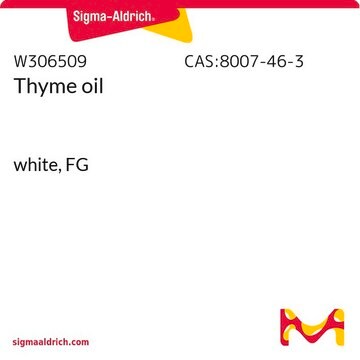W306606
Thymol
FCC, FG
Sinónimos:
2-Isopropyl-5-methylphenol, 5-Methyl-2-(1-methylethyl)phenol, 5-Methyl-2-isopropylphenol, IPMP
Seleccione un Tamaño
48,80 €
Seleccione un Tamaño
About This Item
48,80 €
Productos recomendados
origen biológico
synthetic
Nivel de calidad
300
400
grado
FG
Halal
Kosher
Agency
meets purity specifications of JECFA
cumplimiento norm.
EU Regulation 1334/2008 & 872/2012
FCC
FDA 21 CFR 172.515
presión de vapor
1 mmHg ( 64 °C)
bp
232 °C (lit.)
mp
48-51 °C (lit.)
densidad
0.965 g/mL at 25 °C (lit.)
aplicaciones
flavors and fragrances
Documentación
see Safety & Documentation for available documents
alérgeno alimentario
no known allergens
Organoléptico
spicy; phenolic
cadena SMILES
CC(C)c1ccc(C)cc1O
InChI
1S/C10H14O/c1-7(2)9-5-4-8(3)6-10(9)11/h4-7,11H,1-3H3
Clave InChI
MGSRCZKZVOBKFT-UHFFFAOYSA-N
¿Está buscando productos similares? Visita Guía de comparación de productos
Categorías relacionadas
Descripción general
Aplicación
Acciones bioquímicas o fisiológicas
Otras notas
Cláusula de descargo de responsabilidad
Palabra de señalización
Danger
Frases de peligro
Consejos de prudencia
Clasificaciones de peligro
Acute Tox. 4 Oral - Aquatic Chronic 2 - Eye Dam. 1 - Skin Corr. 1B
Código de clase de almacenamiento
8A - Combustible corrosive hazardous materials
Clase de riesgo para el agua (WGK)
WGK 2
Punto de inflamabilidad (°F)
240.8 °F - closed cup
Punto de inflamabilidad (°C)
116 °C - closed cup
Equipo de protección personal
dust mask type N95 (US), Eyeshields, Faceshields, Gloves, type P3 (EN 143) respirator cartridges
Elija entre una de las versiones más recientes:
¿Ya tiene este producto?
Encuentre la documentación para los productos que ha comprado recientemente en la Biblioteca de documentos.
Los clientes también vieron
Filtros activos
Nuestro equipo de científicos tiene experiencia en todas las áreas de investigación: Ciencias de la vida, Ciencia de los materiales, Síntesis química, Cromatografía, Analítica y muchas otras.
Póngase en contacto con el Servicio técnico








